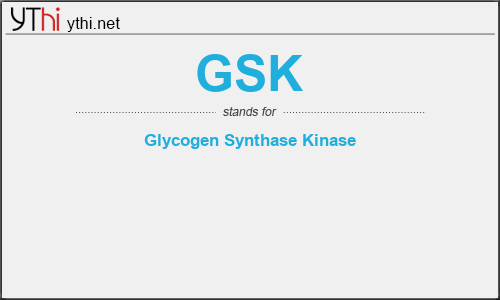What does GSK mean? What is the full form of GSK?
The full form of GSK is Glycogen Synthase Kinase.
Glycogen synthase kinase 3 (GSK-3) is implicated in multiple biological processes including metabolism, gene expression, cell fate determination, proliferation, and survival. GSK-3 activity is inhibited through phosphorylation of serine 21 in GSK-3α and serine 9 in GSK-3β. These serine residues of GSK-3 have been previously identified as targets of protein kinase B (PKB/Akt), a serine/threonine kinase located downstream of phosphatidylinositol 3-kinase. Here, we show that serine 21 in GSK-3α and serine 9 in GSK-3β are also physiological substrates of cAMP-dependent protein kinase A. Protein kinase A physically associates with, phosphorylates, and inactivates both isoforms of GSK-3. The results indicate that depending on the stimulatory context, the activity of GSK-3 can be modulated either by growth factors that work through the phosphatidylinositol 3-kinase–protein kinase B cascade or by hormonal stimulation of G protein-coupled receptors that link to changes in intracellular cAMP levels.
Glycogen synthase kinase 3 (GSK-3), a ubiquitously expressed and evolutionarily conserved protein serine/threonine kinase, was originally identified as an enzyme that regulates glycogen synthesis in response to insulin (1). More recent studies implicate GSK-3 in multiple biological processes. GSK-3 phosphorylates a broad range of substrates, including several transcription factors such as c-Myc, c-Jun, and c-Myb (2) and the translation factor eIF2B (3). GSK-3 has also been implicated in the regulation of cell fate in Dictyostelium (4) and is a component of the Wnt signaling pathway required for Drosophila and Xenopus development (5–8). In mammalian cells, on stimulation with insulin or other growth factors, GSK-3 is rapidly phosphorylated at serine 21 in GSK-3α or serine 9 in GSK-3β, resulting in inhibition of GSK-3 kinase activity (9–12). Protein kinase B (PKB/Akt), a serine/threonine kinase located downstream of phosphatidylinositol 3-kinase (PI3K), has been demonstrated to phosphorylate both of these sites in vitro and in vivo, suggesting that growth factors down-regulate GSK-3 activity through the PI3K–PKB signaling cascade (10, 12). Consistent with its position downstream of the PI3K–PKB pathway, GSK-3 activity suppresses cell proliferation and survival (1, 13, 14).
The present study identifies a mode of GSK-3 phosphorylation and inactivation independent of a functional PI3K–PKB pathway. We demonstrate that serine 21 in GSK-3α and serine 9 in GSK-3β are also physiological substrates of cAMP-dependent protein kinase A (PKA). PKA physically associates with, phosphorylates, and inactivates both isoforms of GSK-3. Thus PKA functions as a GSK-3 kinase that, in parallel with PKB, controls the activity of the multifunctional enzyme GSK-3.
GSK
means
Glycogen Synthase Kinase![]()
Translate Glycogen Synthase Kinase to other language.


Leave a Reply
You must be logged in to post a comment.